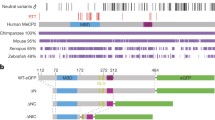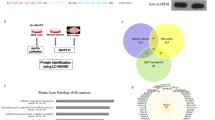Abstract
MeCP2 is a protein highly expressed in the brain that participates in the genetic expression and RNA splicing regulation. MeCP2 binds preferably to methylated DNA and other nuclear corepressors to alter chromatin. MECP2 gene mutations can cause rett syndrome (RTT), a severe neurological disorder that affects around one in ten thousand girls. In this paper, Molecular Dynamics (MD) simulations were performed to scrutinize how the MeCP2 P152R mutation influences the protein binding to DNA. Also, the Umbrella Sampling technique was used to obtain the potential mean forces (PMFs) of both wild-type and mutated MeCP2 Methyl-CpG-binding domain (MBD) binding to both non-methylated and methylated DNA. P152R is a common missense mutation in MBD associated with RTT; however, there are no studies that explain how it causes protein dysfunction. The results from this study hypothesize that P152R mutation leads to MBD binding more strongly to DNA, while selectively decreasing binding affinity to methylated DNA. These provide an explanation for previous not conclusive experimental results regarding the mechanism of how this mutation affects the binding of the protein to DNA, and subsequently its effects on RTT. Furthermore, the results of this research-in-progress can be used as the basis for further investigations into the molecular basis of RTT and to potentially reveal a target for therapy in the future.





Similar content being viewed by others
Abbreviations
- 5mC:
-
5-methylcytosine
- DSM-IV:
-
Diagnostic and statistical manual of mental disorders, fourth edition
- FEP:
-
Free energy perturbation
- GAFF:
-
General amber force field
- ∆G:
-
Gibbs free energy
- HDAC:
-
Histone deacetylases
- NPT:
-
Isothermal–isobaric
- MBD:
-
Methyl-binding domain
- MeCP2:
-
Methyl CpG binding protein 2
- MECP2:
-
Methyl CpG binding protein 2 gene
- MetDNA:
-
Methylated-DNA
- MD:
-
Molecular dynamics
- PMF:
-
Potential of mean force
- PDB:
-
Protein data bank
- RESP:
-
Restrained electrostatic potential
- RMSD:
-
Root mean square deviation
- RMSF:
-
Root mean square fluctuations
- SeMet:
-
Selenomethionine
- SAS:
-
Solvent accessibility surface
- TRD:
-
Transcriptional repression domain
- WHAM:
-
Weight histogram analysis method
References
Dragich J, Houwink-Manville I, Schanen C (2000) Rett syndrome: a surprising result of mutation in MECP2. Hum Mol Genet 9:2365–2375
Akbarian S, Jiang Y, Laforet G (2006) The molecular pathology of Rett syndrome: synopsis and update. Neuromol Med 8:485–494
Guy J, Gan J, Selfridge J, Cobb S, Bird A (2007) Reversal of neurological defects in a mouse model of Rett syndrome. Science 315:1143–1147
Neul JL, Fang P, Barrish J, Lane J, Caeg EB, Smith EO, Zoghbi H, Percy A, Glaze DG (2008) Specific mutations in methyl-CpG-binding protein 2 confer different severity in Rett syndrome. Neurology 70:1313–1321
Amir RE, Van den Veyver IB, Wan M, Tran CQ, Francke U, Zoghbi HY (1999) Rett syndrome is caused by mutations in X-linked MECP2, encoding methyl-CpG-binding protein 2. Nat Genet 23:185–188
Neul JL, Zoghbi HY (2004) Rett syndrome: a prototypical neurodevelopmental disorder. Neuroscientist 10:118–128
Christodoulou J, Grimm A, Maher T, Bennetts B (2003) RettBASE: the IRSA MECP2 variation database—a new mutation database in evolution. Hum Mutat 21:466–472
Kudo S, Nomura Y, Segawa M, Fujita N, Nakao M, Schanen C, Tamura M (2003) Heterogeneity in residual function of MeCP2 carrying missense mutations in the methyl CpG binding domain. J Med Genet 40:487–493
Skene PJ, Illingworth RS, Webb S, Kerr ARW, James KD, Turner DJ, Andrews R, Bird AP (2010) Neuronal MeCP2 is expressed at near histone-octamer levels and globally alters the chromatin state. Mol Cell 37:457–468
Collins AL, Levenson JM, Vilaythong AP, Richman R, Armstrong DL, Noebels JL, Sweatt D,J. and Zoghbi HY (2004) Mild overexpression of MeCP2 causes a progressive neurological disorder in mice. Hum Mol Genet 13:2679–2689
Caballero IM, Hendrich B (2005) MeCP2 in neurons: closing in on the causes of Rett syndrome. Hum Mol Genet 14:R19–R26
Roloff TC, Ropers HH, Nuber UA (2003) Comparative study of methyl-CpG-binding domain proteins. BMC Genom 4:1
Lyst MJ, Ekiert R, Ebert DH, Merusi C, Nowak J, Selfridge J, Guy J, Kastan NR, Robinson ND, De Lima Alves F et al (2013) Rett syndrome mutations abolish the interaction of MeCP2 with the NCoR/SMRT co-repressor. Nat Neurosci 16:898–902
Ohki I, Shimotake N, Fujita N, Jee J, Ikegami T, Nakao M, Shirakawa M (2001) Solution structure of the methyl-CpG binding domain of human MBD1 in complex with methylated DNA. Cell 105:487–497
Ho KL, McNae IW, Schmiedeberg L, Klose RJ, Bird AP, Walkinshaw MD (2008) MeCP2 binding to DNA depends upon hydration at methyl-CpG. Mol Cell 29:525–531
Klose RJ, Sarraf SA, Schmiedeberg L, McDermott SM, Stancheva I, Bird AP (2005) DNA binding selectivity of MeCP2 due to a requirement for A/T sequences adjacent to methyl-CpG. Mol Cell 19:667–678
Agarwal N, Becker A, Jost KL, Haase S, Thakur BK, Brero A, Hardt T, Kudo S, Leonhardt H, Cardoso MC (2011) MeCP2 Rett mutations affect large scale chromatin organization. Hum Mol Genet 20:4187–4195
Zou X, Ma W, Solov’yov IA, Chipot C, Schulten K (2012) Recognition of methylated DNA through methyl-CpG binding domain proteins. Nucleic Acids Res 40:2747–2758
Ballestar E, Yusufzai TM, Wolffe AP (2000) Effects of Rett syndrome mutations of the methyl-CpG binding domain of the transcriptional repressor MeCP2 on selectivity for association with methylated DNA. Biochemistry 39:7100–7106
Lemkul JA, Bevan DR (2010) Assessing the stability of Alzheimer’s amyloid protofibrils using molecular dynamics. J Phys Chem B 114:1652–1660
Torrie GM, Valleau JP (1974) Monte Carlo free energy estimates using non-Boltzmann sampling: application to the sub-critical Lennard-Jones fluid. Chem Phys Lett 28:578–581. https://doi.org/10.1016/0009-2614(74)80109-0
Torrie GM, Valleau JP (1977) Nonphysical sampling distributions in Monte Carlo free-energy estimation: umbrella sampling. J Comput Phys 23:187–199. https://doi.org/10.1016/0021-9991(77)90121-8
Hub JS, de Groot BL, van der Spoel D (2010) g_wham—a free weighted histogram analysis implementation including robust error and autocorrelation estimates. J Chem Theory Comput 6:3713–3720. https://doi.org/10.1021/ct100494z
Guex N, Peitsch MC (1997) SWISS-MODEL and the Swiss-Pdb Viewer: an environment for comparative protein modeling. Electrophoresis 18:2714–2723
Case DA, Cheatham TE, Darden T, Gohlke H, Luo R, Merz KM, Onufriev A, Wang Simmerling,C,B. and Woods RJ (2005) The Amber biomolecular simulation programs. J Comput Chem 26:1668–1688
DeLano WL (2002) The PyMOL molecular graphics system, version 1.1. Schrödinger LLC, New York
Duan Y, Wu C, Chowdhury S, Lee MC, Xiong G, Zhang W, Yang R, Cieplak P, Luo R, Lee T et al (2003) A point-charge force field for molecular mechanics simulations of proteins based on condensed-phase quantum mechanical calculations. J Comput Chem 24:1999–2012
Hess B, Kutzner C, van der Spoel D, Lindahl E (2008) GROMACS 4: algorithms for highly efficient, load-balanced, and scalable molecular simulation. J Chem Theory Comput 4:435–447
Hoover W (1985) Canonical dynamics: equilibrium phase-space distributions. Phys Rev A 31:1695–1697. https://doi.org/10.1103/PhysRevA.31.1695
Berendsen HJC, Postma JPM, van Gunsteren WF, DiNola A, Haak JR (1984) Molecular dynamics with coupling to an external bath. J Chem Phys 81:3684. https://doi.org/10.1063/1.448118
Parrinello M (1981) Polymorphic transitions in single crystals: a new molecular dynamics method. J Appl Phys 52:7182. https://doi.org/10.1063/1.328693
Abraham MJ, Gready JE (2011) Optimization of parameters for molecular dynamics simulation using smooth particle-mesh Ewald in GROMACS 4.5. J Comput Chem 32:2031–2040
Darden T, York D, Pedersen L (1993) Particle mesh Ewald: an N⋅log(N) method for Ewald sums in large systems. J Chem Phys 98:10089. https://doi.org/10.1063/1.464397
Hess,B., Bekker,H., Berendsen,H.J.C. and Fraaije,J.G.E.M. (1997) LINCS: a linear constraint solver for molecular simulations. J Comput Chem 18, 1463–1472. https://doi.org/10.1002/(SICI)1096-987X(199709)18:12%3C1463::AID-JCC4%3E3.0.CO;2-H
Garbuzynskiy SO, Melnik BS, Lobanov MY, Finkelstein A, V, Galzitskaya OV (2005) Comparison of X-ray and NMR structures: is there a systematic difference in residue contacts between X-ray- and NMR-resolved protein structures? Proteins 60:139–147
Free A, Wakefield RI, Smith BO, Dryden DT, Barlow PN, Bird AP (2001) DNA recognition by the methyl-CpG binding domain of MeCP2. J Biol Chem 276:3353–3360
Funding
This work was supported by FAPEMIG (Grant Number: APQ-01821-11).
Author information
Authors and Affiliations
Corresponding author
Ethics declarations
Conflict of interest
The author declares no conflicts of interest in relation to this work.
Electronic supplementary material
Below is the link to the electronic supplementary material.
Figure S1
. Wildtype of the MeCP2 MBD C-α Covariance Matrices. Obtained from 100ns of non-restrained MD simulations. (TIFF 13913 KB)
Figure S2
. P152R mutant of the MeCP2 MBD C-α Covariance Matrices. Obtained from 100ns of non-restrained MD simulations. (TIFF 13913 KB)
Figure S3
. MeCP2 MBDs C-α Root Mean Square Fluctuations (RMSF). The RMSF for the wild-type MBD is plotted in black and plotted in red for the mutated MBD. (TIFF 438 KB)
Rights and permissions
About this article
Cite this article
Franklin, D. P152R Mutation Within MeCP2 Can Cause Loss of DNA-Binding Selectivity. Interdiscip Sci Comput Life Sci 11, 10–20 (2019). https://doi.org/10.1007/s12539-019-00316-z
Received:
Revised:
Accepted:
Published:
Issue Date:
DOI: https://doi.org/10.1007/s12539-019-00316-z




